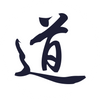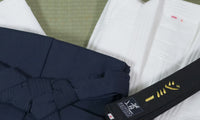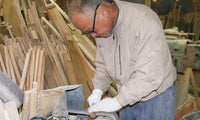Aizome - Japanese Indigo on Martial Arts Equipment
Visit to the Nogawa workshop - From the leaf to the Hakama
Aizome dyeing, indigo blue, also known as "Japanese blue", is a traditional dyeing existing since the dawn of time. It has long been used in many fields: for working clothes, decorative fabrics to samurai garments and armors. Nogawa Masatoshi, 3rd generation, welcomes us in his studio and introduces to us the traditional indigo as the Nogawa workshop has been making it since 1914.

Indigo Fabric Manufacture for Kendogi at the Nogawa workshop
We decided to talk about indigo because this tincture is especially used for the dyeing of Traditional Hakama, Dogi and Bogu (armor) and various equipment used in Japanese martial arts. Our team went to Saitama, a 2-hours train ride to the north of Tokyo, and more precisely to the Hanyu district, one of the famous places for Japanese indigo, existing now for more than a centennial.
This traditional Aizome dyeing fell into disuse in the second half of the 20th century and many manufacturers had to restructure their activities, as was the case of Mr. Nogawa. About 40 years ago, he associated with his indigo fabric production workshop an atelier for traditional martial arts Hakama and Dogi, labeled Bushu Ichi.
The Aizome
Why? Why keep this strongly smelling tincture that rubs off and is expensive?
The first reason is purely Japanese: tradition. We, martial arts practitioners, should be the first to understand this. Tradition is something important for the Japanese, it is what structures our practice and guarantees the quality of what we learn. And then, let's be pragmatic, as the Japanese say, "tradition is good for health".
In fact, it appears that artisans working with their hands in dyeing all day long are sick less often and live longer than the average person. The head of the workshop, still working and in good shape at over 80 years of age, testifies to this.
From a more scientific point of view, this dye has several interesting properties. Its odor is a natural repellent for insects and other small animals.
A property that has not been ignored by the workers on the fields or the samurai. Another interesting characteristic is its antiseptic effect, that allows wound cleansing and wound healing, especially useful for manual workers and combatants. (Although, of course, miracles cannot be expected.)
And last but not least: It softens the fabric, especially the cotton. This last feature certainly matters to most martial arts practitioners wearing a Hakama!
History of the Indigo
It is difficult to know precisely when the Indigo was discovered. We know that it has been used already more than 1000 years ago in India and later in China. India being a warmer country, a natural fermentation occurs during the making of the dye, however, its particular properties described above, remain well below the Japanese Aizome. The legend tells that the first dye used by Levi Strauss for the gold seekers' jeans, was indigo from India, back then a British colony.
Although this is difficult to verify, the similarity between "blue jeans" and the indigo is striking.
As for Chinese dyeing, it does not undergo such a process of fermentation, and in Japan it is therefore called "Ryukazome", the dyeing of the dragon, because it rubs off leaving purple stains, unlike the Japanese indigo that is of navy blue, the famous "Japanese blue".
In Japan we can trace it back to the 14th century, but the process is probably much older. Used over time as garment for workers, then as raw material for exquisite clothing destined for the nobility, then in the manufacture of samurai equipment, and finally today, in the manufacture of martial art equipment and in the manufacture of traditional fabrics (Furoshiki, curtains, etc..) mostly intended for decoration.
With the development of the chemical industry, chemical dyes have gradually come to replace the Aizome. The sector has converted into the manufacture of luxury fabrics and decoration, but many workshops have disappeared. It was only the growing popularity of Kendo in the 20th century that made revive the activity, mainly for the dyeing of the armor, Kendogi and Hakama.
The Manufacturing Process and the Aizome
"Bushu", a label that you find on our equipment, actually refers to the manufacturing process of the Indigo. To guarantee authentic and high-quality manufacturing, several manufacturers of Saitama (greater Tokyo area), including Mr. Nogawa's workshop, laid the foundation for this Bushu process.

1 - Each summer, before flowering, the leaves are picked of the Polygonum Tinctorum, widely spread from Europe to Asia, at the origin of the so-called color "indigo". These leaves are then crushed with a mallet and stored in large canvas bags for about 3 months until the leaves begin to decompose.

2 - Once these three months have passed, the compost obtained is placed in large tanks with a catalyst of natural fermentation, wheat flour, and of course, water. The fermentation then begins and the mixture must be monitored and stirred daily. Since the fermentation is a natural and living process (carried out by bacteria), the mixture requires special attention. The artisan will ensure that the mixture maintains an optimum density for dyeing. The temperature of these vessels must be stabilized at 36° and 37° degrees.

3 - When the artisan gives the green light, the dye can begin. The cotton balls (not spun yet) are immersed in successive baths, so that the dye penetrates the fiber at depth. Numerous tanks are aligned containing the mixture at several stages of fermentation. When a tank is emptied of its dye, it is filled for a new fermentation process and the neighboring tank is opened. Like that, production can continue throughout the year.

4 - The balls of wool are then dried for several days. This is the only step where modern technology intervenes: A dry ventilation allowing to accelerate the drying was installed. In this picture, the head of the workshop with more than 50 years of experience, and far from ready to retire.

5 -The cotton is then spun and put on a reel. The coils are aligned on looms, adjusted for the weaving of different types of fabrics: The fabric for Dogi, the most complex, but mostly the fabric for Hakama. This fabric is then rolled up and sold as is or used directly by the Nogawa workshop for the manufacture of garment.

6 - The only thing left to do is to manufacture the clothes! The workshop Nogawa makes the "Bushu Ichi", ranging from Hakama and Dogi (Aikido, Kendo and Iaido) to traditional clothing (Samue, Jinbei, Tabi, gloves etc.) and accessories (Furoshiki, belts, pouches). But the workshop also directly resells its fabrics to many workshops, including our tailors, sewing the traditionally hand-made Hakama.
Besides respect for tradition, the "Bushu Process" label guarantees that the fabric is used was dyed starting from the yarn, to achieve a dye much more resistant, with a perfectly uniform coloring, as you can see on the pictures of our Hakama below.

Hakama Seido Aizome #10000
The Fabric Used in the Manufacture of Hakama
Cotton Hakama are often categorized from #5000 to #11000. One then naturally thinks that the higher the number, the better the quality. This is not entirely true. This number corresponds to the mesh of the fabric (number of threads on a certain surface). The thinner and tighter the weave, the more threads there are and the stronger the fabric. But the stronger the fabric, the stiffer it is.
In the manufacture of Hakama, it is generally accepted that the maximum is #11000, beyond, the loss of flexibility would handicap the practitioner. The other element concerns the thickness of the threads. Indeed, the Hakama #6000 has fewer woven threads than the #10000, but as they are thicker, the actual amount of cotton itself is therefore substantially the same, the weight of the Hakama also.
One (including ourselves) tend to announce that the # 11000 is "super heavy" and the # 6000 medium-heavy. The weight is actually relatively close (the 10'000 does not double the weight of the 5000), but the stiffness of the # 11000 results in a sensation of greater weight.
In addition to the difference in the complexity of the weaving, the higher pricing for #10000 and #11000 fabrics is mainly due to the difficulty in working the fabric. These Aizome Hakama are usually hand sewn and the #10000 fabric is much harder to pierce with a needle than the # 6000. So it takes more time, and more effort to make these so-called "high-end" models. This is especially true in the case of our Aizome Hakama, as they are all hand sewn.
The Nogawa Workshop
In this workshop are about twenty people employed. Four work on the indigo itself, the others work in the making of the fabric and the manufacture of clothes.
Mr. Nogawa's workshop is particularly interesting, particularly for the reason why he did not agree to work directly with us. Mr. Nogawa wants to be sure to work only with people who respect and know his work.
Completely obsessed with the quality of the dyeing and its equipment, the conversation turned only around the manufacturing process, from the indigo itself to the methods of weaving, cutting and sweing martial arts equipment, to the sales techniques of some resellers being very "opaque" concerning the origin of their Indigo products. There is no doubt for our team that the equipment "Bushu Ichi" of the workshop Nogawa are of the best quality possible.
But Mr. Nogawa grants his confidence to one of our tailors for Hakama. Having him as fabric supplier for some of our Aizome products is also one of the reasons that make us proud of our brand!
If you like the subject and want to learn more, you can have a look to Guillaume Erard's article WAKIMACHI, THE CENTER OF AIZOME IN SOUTH JAPAN, which will give you an insight of the Aizome industry in Kyushu (south Japan).

On the left: Sewing workshop and office, on the right: Indigo dye workshop






1 コメント - Aizome - Japanese Indigo on Budo Equipment
Bonjour, je suis membre d’un club d’aïkido de la région de Lyon, nous sommes d’ailleurs plusieurs à utiliser vos produits. Nous envisageons de faire un voyage de 15 jours au Japon en avril 2025 et à cette occasion nous aimerions savoir si à votre connaissance il serait possible de visiter un atelier de confection de hakama. Nous aurions également apprécié de voir une fabrique de bokken mais comme je l’ai vu dans votre article, le village qui regroupe ces ateliers est trop loin pour nous et nous n’aurons pas le temps de nous y rendre. Dans l’attente de vote réponse, veuillez recevoir mes salutations sportives. Luc